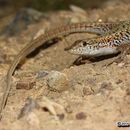en
names in breadcrumbs


Least Concern
A small, slender lizard. Largest Egyptian specimen has a SVL of 42 mm. Tail proportionately relatively long, average tail/SVL ratio = 2.4 (n=4). Supraciliaries separated from supraoculars by small granules; tympanum partly covered by a kidney-shaped tympanic shield; supratem-porals large distinct from other temporals; occipital absent or very small. Dorsals medium-sized (22-32) imbricate, strongly keeled; 6 ventrals; 9-11 femoral pores (based on 14 specimens form Egypt and Israel). Dorsal parts generally grayish; pattern striated, composed of 4 dark and light stripes; color and pattern has the same intensity and contrast along the entire back; limbs with dark marbling; venter grayish white.
Barbour (1914) first reported Ophisops elegans in Sinai from a locality named "Fuweila." Flower (1933) and Schmidt and Marx (1956) list the species for Sinai apparently based on this report. Later Hoofien (1965) determined that this locality is in fact in Jordan, thus excluding it from the Egyptian fauna. The next mention of the species in Egypt was by Marx (1968), who reported its occurrence along the Mediterranean coast west of Alexandria. These animals, as it turns out, are actually referable to the North African O. occidentalis. In fact, the first and only substantiated report of O. elegans from Egypt is that by Baha El Din (1992), who found the species from near El Quseima in northeastern Sinai, where the only Egyptian specimens were collected.The species could possibly be found in other similar habitats in the hills of North Sinai, such as Gebel Maghara.
North Sinai, Israel, Palestine, and Jordan.
Inhabits lightly to fairly well-vegetated rocky hillsides and wadis. In the El Quseima area it was found in small runnels with Lycium shawii bushes and dense spinose vegetation.
Uncommon and highly localized. Common outside Egypt, but local populations could be lost if current habitat degradation in the El Quseima area continues. In Egypt it is Vulnerable on account of its small range.
Ophisops elegans, commonly known as the snake-eyed lizard, is a species of lizard in the family Lacertidae. The species is endemic to the Mediterranean region and Central Asia. There are nine recognized subspecies.
O. elegans has the following distinguishing characters: Head moderate, feebly depressed. Upper head-shields smooth or slightly rugose; nostril lateral, pierced between on upper and a lower nasal, and followed by one or two postnasals; frontonasal single; four supra-oculars, first and fourth very small, the two principal separated from the supraciliaries by a series of granules: occipital small, in contact with or separated from the interparietal; subocular bordering the lip, normally between the fourth and fifth upper labials; temporal scales small, smooth; usually two large supratemporal shields bordering the parietal; a large tympanic shield. A. gular fold may be distinguishable; collar absent or feebly marked. Dorsal scales variable in size, as large as or larger than the laterals; 30 to 40 scales round the middle of the body, ventrals included. A more or less enlarged postero-median preanal plate. The hind limb reaches about the ear in the male, the shoulder or a little beyond in the female. 7 to 12 (usually 9 to 11) femoral pores on each side. Tail about twice as long as head and body. Olive or bronzy above, with black spots usually forming longitudinal series, sometimes forming a network; frequently and or two light longitudinal streaks on each side; lower surfaces white.[2]
From snout to vent 2 inches (5 cm); tail 4 inches (10 cm).
The following nine subspecies are recognized as being valid, including the nominotypical subspecies.[3]
Nota bene: A trinomial authority in parentheses indicates that the subspecies was originally described in a genus other than Ophisops.
The subspecific name, schlueteri, is in honor of Wilhelm Schlüter, who was a German dealer of natural history specimens.[4]
O. elegans is found in E Georgia, Armenia, Azerbaijan, SE Bulgaria, NE Greece (Lesbos, Limnos, Chios, Romania, Samos, Samothraki, Agathonisi, Psara), Cyprus, Turkey, Algeria, Libya, Egypt,[5] W Syria, Lebanon, Israel, W Jordan, Iraq, Iran (Kavir desert), N Pakistan, NW India.
Races:
Type locality: Baku, Azerbaijan.
The preferred natural habitats of O. elegans are grassland, shrubland and forest, at altitudes of 400–2,000 m (1,300–6,600 ft).[1]
Ophisops elegans, commonly known as the snake-eyed lizard, is a species of lizard in the family Lacertidae. The species is endemic to the Mediterranean region and Central Asia. There are nine recognized subspecies.